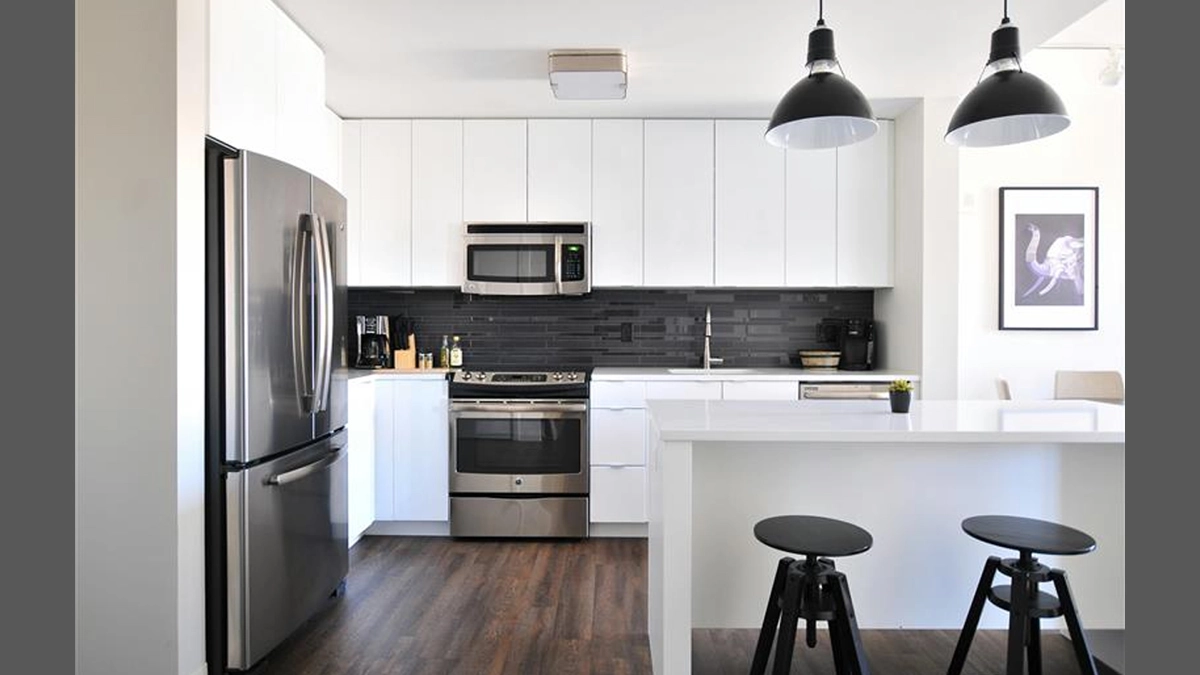Copyright latestly

When redesigning a kitchen or replacing an old appliance, one crucial question quickly arises: Which cooling system truly fits my lifestyle? In a world where design, energy efficiency, and smart technology merge seamlessly, choosing the ideal model has become both a practical and aesthetic decision. The process of “How to choose the perfect fridge: Balancing design, efficiency, and space” is not just about picking an appliance — it’s about making a choice that impacts your comfort, sustainability, and daily rhythm for years to come. Finding that perfect balance requires a deep understanding of your habits, your available space, and your priorities. Today’s cooling solutions go far beyond simple storage — they enhance convenience, preserve freshness, and complement interior design. From compact integrated models to statement pieces with advanced smart features, the variety can be overwhelming. Yet, with clear priorities and knowledge of energy labels, you can turn the selection process into an exciting design decision rather than a daunting task. Design as a Reflection of Lifestyle Design is no longer a secondary aspect of choosing a cooling appliance — it’s central. In modern kitchens, the refrigerator or freezer isn’t merely a functional item; it’s part of the home’s visual identity. Whether stainless steel, matte glass, or retro-inspired curves, the aesthetic element reflects personal taste and lifestyle. Good design also incorporates usability: ergonomic handles, soft-close doors, flexible shelving systems, and elegant LED lighting are now expected rather than exceptional. Beyond pure aesthetics, functionality is increasingly tied to personalization. Built-in units disappear into cabinetry for a minimalist look, while freestanding models make bold statements in open-plan kitchens. Some manufacturers even offer interchangeable panels or modular layouts, giving homeowners the freedom to adapt their appliance to evolving interior styles and needs. This flexibility highlights how design and practicality can coexist beautifully. “A great cooling appliance doesn’t just blend into your kitchen — it enhances it by adding comfort, functionality, and character.” Ease of use is another vital design consideration. Touch controls, intuitive displays, and adaptive illumination make daily operation simpler and more enjoyable. Innovations such as adjustable shelf systems, anti-fingerprint finishes, and reversible door hinges all demonstrate how deeply the design process now considers the user experience. Modern appliances embody the harmony between engineering precision and everyday usability — a reflection of thoughtful living. Energy Efficiency as a Core Buying Factor Energy efficiency has become one of the most important factors when purchasing a new appliance. Unlike other household devices, cooling systems operate continuously — 24 hours a day, 365 days a year. This constant operation means even small improvements in energy consumption can have a significant impact on both electricity bills and the environment. Models in the top energy efficiency classes (A or B) are equipped with optimized compressors, improved insulation, and advanced sensor technologies to maintain ideal temperatures with minimal power usage. Behind efficiency lies an intricate network of innovations. No-Frost systems prevent ice build-up, dynamic cooling distributes air evenly across all compartments, and intelligent sensors adjust performance to the contents and external temperature. Quiet operation is another key factor: the most efficient models often produce less than 35 dB of noise, making them perfect for open-plan living spaces. Below is a brief comparison to help clarify the differences between energy classes: Energy Class Average Annual Power Use Noise Level Best For A ~100 kWh < 35 dB Eco-conscious households B ~130 kWh 35–38 dB Mid-size families C ~150 kWh up to 40 dB Occasional users or budget buyers A few practical guidelines when evaluating efficiency: Always check the EU energy label and focus on realannual consumption, not just the class. Look for inverter compressors— they adjust power dynamically, saving substantial energy over time. Consider the long-term value: a slightly higher upfront cost for a better-rated appliance will pay off in reduced electricity bills. Space Planning and Capacity Considerations Before you fall in love with a particular design or finish, it’s vital to understand how the appliance will function within your space. Kitchen layouts vary enormously, and what works in a large open-plan home may be entirely impractical in a compact apartment. Space planning is therefore not only about dimensions — it’s about accessibility, airflow, and integration with your kitchen’s workflow. When planning, consider how often you cook, how many people live in your household, and whether you buy groceries daily or weekly. For instance, a couple living in an urban apartment might prefer a slim, built-in cooling unit that maximizes floor area, while a family of five could benefit from a double-door or side-by-side configuration with ample freezer space. The way doors open — left, right, or French-style — can also dramatically affect comfort and traffic flow in tight spaces. To make your planning easier, here’s a simplified breakdown of capacity requirements and ideal setups: Household Size Recommended Net Volume Suggested Configuration 1–2 people 100–200 liters Compact single-door or built-in model 3–4 people 250–350 liters Freestanding or bottom-freezer type 5+ people 400+ liters Side-by-side or multi-door model A few secondary but highly practical space-saving ideas: Reversible doorsallow flexible placement without limiting layout options. Sliding shelvesimprove reachability, especially for upper sections. Adjustable binsmake it easier to store tall bottles or large containers without wasting space. Ultimately, the goal is not just to “fit” an appliance into your kitchen but to ensure it enhances your daily efficiency. The perfect model adapts to your lifestyle — not the other way around. Smart Technology and Modern Features Today’s cooling appliances are smarter, quieter, and more connected than ever before. The integration of smart technology has turned refrigerators into intelligent assistants that not only preserve food but actively help manage it. Features like internal cameras, Wi-Fi connectivity, and voice assistant compatibility allow you to check what’s inside your appliance while shopping, receive temperature alerts, or even adjust cooling zones via your smartphone. These innovations bring real benefits. For example, smart temperature zoning ensures optimal freshness for fruits, vegetables, meats, and dairy products — all without manual intervention. Some models even suggest energy-saving modes when they detect that the door has been left open too long. Beyond convenience, such features contribute to sustainability by reducing waste and optimizing power consumption. Smart technology also makes maintenance simpler. Many high-end models include self-diagnosing systems that notify users of potential issues before they escalate. Combined with digital touch interfaces and customizable settings, these appliances provide both precision and comfort. As our homes become more connected, the role of such technology is bound to expand — not to complicate life, but to simplify it. Balancing Cost, Longevity, and Value Price is, of course, a deciding factor — but understanding value requires looking beyond the initial cost. A cheaper model may appear attractive at first glance, yet long-term energy use, repair frequency, and limited features can turn it into an expensive choice over time. Instead, consider the total cost of ownership: purchase price, energy consumption, and lifespan. High-quality models often justify their higher price through durable materials, quieter operation, and extended warranties. Stainless steel hinges, precision-engineered compressors, and LED lighting systems may seem like small details, but they collectively add years of reliable service. Moreover, premium brands tend to have better insulation technology, which not only reduces energy usage but also ensures consistent cooling performance — crucial for maintaining food freshness. To weigh your options, think in terms of investment, not expense: A high-efficiency model can save up to 30%in energy costs over ten years. Longer warranties and better after-sales support reduce hidden costs. Durable materials prevent premature wear and replacements. Choosing wisely means finding a balance between short-term affordability and long-term savings — a mindset that echoes sustainable living itself. Sustainability and Environmental Impact Sustainability has become a core consideration in every aspect of modern living, and choosing a cooling appliance is no exception. Consumers today are far more aware of how their purchasing decisions affect the planet. A well-chosen appliance not only minimizes energy consumption but also reduces greenhouse gas emissions throughout its lifecycle — from production and operation to eventual recycling. Many brands now design their models with recyclable materials, eco-friendly refrigerants, and longer lifespans to reduce environmental impact. For example, hydrocarbon-based refrigerants (like R600a) have replaced older, harmful substances such as CFCs and HFCs, significantly lowering the appliance’s global warming potential. Additionally, innovations like vacuum insulation panels (VIP) have dramatically improved thermal efficiency while reducing the overall material needed for insulation. But sustainability doesn’t end at manufacturing. How you use your appliance matters just as much. Here are some key habits that help maximize energy performance and lifespan: Avoid overfilling— overcrowded compartments block airflow and increase power consumption. Clean condenser coilsregularly to prevent the compressor from overworking. Position the unitaway from direct sunlight or heat sources such as ovens or dishwashers. Defrost periodically, even if your model has a No-Frost feature, to maintain peak efficiency. Such mindful usage ensures not only better cooling performance but also contributes to reducing your household’s overall carbon footprint. Sustainability, at its core, is about extending the value of what you already have — making small, consistent choices that lead to a lasting impact. The Perfect Balance: Bringing Design, Efficiency, and Space Together Choosing the right cooling appliance isn’t about chasing the most expensive or most feature-packed model. It’s about understanding the balance between aesthetic appeal, functional efficiency, and spatial harmony. The best appliance complements your kitchen visually, supports your daily habits, and aligns with your sustainability goals. Whether you prioritize minimalist design, low energy usage, or smart features, the key is finding equilibrium among all these elements. “The perfect cooling appliance is one that quietly supports your lifestyle — saving energy, simplifying routines, and blending seamlessly into your space.” This sentiment captures the essence of the decision-making process described in “How to Choose the Perfect Fridge: Balancing Design, Efficiency, and Space.” It reminds us that technology should not overwhelm, but rather enhance the rhythm of daily life. The smartest choice is the one that offers comfort without compromise — efficiency without excess. When selecting your next appliance, think long-term: Does it complement your kitchen layout? Is it energy-efficient enough to lower costs and environmental impact? Will it still suit your lifestyle in five or ten years?



